
In the realm of gold market analysis, discerning investors and market observers are witnessing an exceptional period marked by significant movements in precious metals. The gold market trends of late 2023 have set a precedent with the gold price forecast indicating a landscape rife with opportunities and strategic considerations for gold investment. Transparency in understanding the multifaceted drivers behind the surging and dipping gold prices remains paramount for stakeholders looking to optimize their positioning in the commodities market.
As the year concluded with record-high valuations, the impetus behind this golden surge is dissected by comprehensive gold market analysis. The intricate interplay of geopolitical conflicts, central bank maneuvers, and macroeconomic policies has shaped the trajectory of gold, underscoring its resilience and reinforcing its contemporary luster amidst other assets. The detailed exploration of these patterns is not only of interest but a necessity for those embedded in the dynamics of gold investment.
An Overview: Gold’s Record High And Market Drivers
The recent ascent to a gold price record high has caught the attention of both analysts and investors. A blend of market drivers has initiated a fervent discussion on the future landscape of precious metal investments. At the core of this discussion is the relationship between the weak US dollar, and its implications on gold valuation. Moreover, the anticipated shift in Federal Reserve policy stands as a pivotal moment for future investment strategies.
Implications Of A Weak U.S. Dollar
In analyzing the catalysts behind the record-setting gold price, one cannot overlook the weak US dollar. A devaluing dollar traditionally portends well for gold, as it boosts its accessibility to holders of other currencies and indicates a potential harbor of wealth during currency fluctuations. As the dollar continues to slacken, the allure of gold grows stronger, invariably positioning it as a compelling asset in a diverse investment portfolio.
Expectations Of Fed Policy On Rate Cuts
The Federal Reserve’s explicit signals towards impending interest rate cuts have fomented a sense of urgency among gold market spectators. With rate reductions on the horizon, potentially initiating in 2024, the stage is set for gold to augment its status as an investment stronghold. These interest rate cuts, expected to alleviate inflation pressures, could inversely propel the gold market to new heights, confirming the metal’s renown as a strategic counterbalance to interest-bearing securities. The investment strategy of hedging against interest rate fluctuations with gold investments may thus evolve as a mainstay approach within the financial sector.
Gold And The Federal Reserve: Rate Cuts As A Price Catalyst
The relationship between the Federal Reserve’s monetary policy and gold prices has long intrigued investors. Recent signals from the Federal Open Market Committee (FOMC) suggest a departure from previous interest rate hikes, with substantial implications for the precious metals market. A shift toward easing policies not only signals a softer stance on inflation but also highlights a pivotal role for Federal Reserve rate cuts as a key gold price catalyst.
Speculation on how forthcoming policies will influence market dynamics is gaining traction. The anticipation of rate cuts is molding investor sentiment and gold price predictions, as the interplay between reduced rates and commodity prices unfolds.
FOMC’s Stance And Future Outlook
The FOMC’s pivot towards a reduction in interest rates comes as a harbinger of change for gold investors. With at least three rate cuts on the horizon, the easing of monetary policy appears imminent as inflationary pressures begin to wane. This withdrawal from hawkish positions points to the potential for gold to breach new frontiers as economic conditions evolve and Federal Reserve rate cuts pave the way for lower interest environments.
Analyst Predictions On Gold Prices In A Lower Rate Environment
Esteemed financial institutions, including J.P. Morgan, have put forward a bullish perspective on the trajectory of gold prices. A consensus among analysts is taking shape around a resurgence in gold’s value, proposing a potential peak of $2,300/oz in the year 2025. This projection aligns with the anticipated timeline for the commencement of the FOMC’s cutting cycle and correlates with anticipated reversals in U.S. GDP growth rates. Such a scenario sets expectations for gold to perform robustly against a backdrop of falling U.S. real yields, reinforcing its esteemed position within investment portfolios.
The Safe-Haven Appeal: Gold’s Performance Amid Geopolitical Unrest
As the geopolitical landscape endures shifts and tremors, investors worldwide continue to look towards gold performance to gauge its reputation as a safe-haven asset. This precious metal has historically seen an uptick in demand during such times of uncertainty. The clashes between Israel–Hamas and the ongoing Russia–Ukraine conflict are glaring examples that feed into the gold market’s dynamism.
Historical Perspective On Gold As A Safe-Haven Asset
The allure of gold as a bulwark against financial storms is not a new phenomenon. Its ability to hold value and even appreciate during volatile periods makes it an essential part of a diversified investment portfolio. The legacy of gold as a safe-haven asset is built on centuries of trust and historical precedence, offering an escape from the depreciation of fiat currencies and the ebbs and flows of the stock market.
The Impact Of Global Tensions On Gold Demand
In the modern era, geopolitical unrest invariably leads to increased gold demand. Notably, this surge is global, with markets in America, Europe, Asia, and the Middle East reflecting heightened acquisitions of gold. Investors prioritize gold not only to safeguard their wealth but also to capitalize on its potential to generate returns amid uncertainty and currency fluctuations.
- Increased acquisition by central banks in nations experiencing or bordering areas of high tension.
- Escalating trade volumes in gold ETFs and securities as market participants seek non-volatile assets.
- A noteworthy uptick in retail investment in physical gold, including coins and bullion.
The outlook for gold, given the current global climate, suggests a perpetuation of this precious metal’s role as a stabilizing force within investment strategies. While the exact trajectory of gold performance is subject to many influences, its intrinsic value as a safe-haven asset during times of geopolitical unrest is irrefutable.
Understanding Gold Price Fluctuations: Anticipated Movements
The landscape of gold investment is perpetually dynamic, bearing numerous patterns and trends that promise a diverse range of investment opportunities. Comprehending these gold price fluctuations is paramount for investors looking to navigate the intricacies of the market. A meticulous market analysis reveals that, akin to the interconnected nature of price cycles, gold’s valuation is influenced by myriad factors, from global economic policies to shifts in investor sentiment.
As we delve deeper into the intricacies of gold’s price cycle, it becomes apparent that strategic market entries and exits can significantly leverage investment outcomes. Whether one is a seasoned trader or exploring new investment opportunities, understanding the inherent volatility of gold prices is crucial to informed decision-making.

Short-Term Dips Vs. Long-Term Gains
Historically, gold markets have demonstrated a propensity for short-term corrections following periods of rapid appreciation, often presenting unique buying opportunities for astute investors. Although a temporary retrenchment in prices can sometimes trigger unwarranted apprehension among stakeholders, market analysis suggests that such movements are an intrinsic aspect of gold’s price cycle. Thus, understanding the timing of these dips is crucial for investors aiming to optimize their long-term gains.
Opportunities For Investors In Gold’s Price Cycle
Financial experts often emphasize the significance of interpreting gold price fluctuations to identify investment opportunities. There’s a consensus that as we approach mid-2024, the market might witness a pivot, shaped by looming U.S. rate cuts, which may inject fresh vigor into the gold market. This anticipation builds upon observable behaviors in past cycles where gold has corrected approximately 10% post-peak, only to rebound more robustly thereafter. Investors keen on capitalizing on these cyclical trends stand to benefit from the forecasted upswing. Being agile and responsive to these market shifts can potentially result in lucrative outcomes.
Forecasting The Future: When Will Gold Reach New Heights?
Gold has forever been a symbol of wealth and stability, and its pricing trends are closely monitored by investors and economists around the globe. As we look forward to the next few years, gold price forecasting has become particularly significant, especially in light of recent economic shifts.
Experts from J.P. Morgan Research have been examining various factors that influence the precious metal’s value, taking into consideration economic growth impact and how inflation influence might drive prices to new summits. Their peak gold prices projections are not just speculative numbers but are based on robust quantitative models and historical data analysis.
Projected Peak Prices Of Gold
The coming years show potential for significant increases in gold prices, with estimations of reaching a zenith. The anticipation of rate adjustments by the Federal Reserve shines a spotlight on the optimistic future of gold pricing, with bullish sentiment permeating the market:
- An ascent to $2,300/oz by 2025 is forecasted.
- A correlation between the Federal Reserve’s policies and the bullish periods in the gold market.
- Series of rate cuts speculated to total 125 basis points in the latter half of 2024 catalyzing the expected rally.
Influences Of Inflation And Economic Growth On Gold Value
Inflation rates and economic indicators are pivotal in shaping gold’s valuation. The intricate dance between these factors and gold pricing has been the subject of many scholarly articles and financial reports:
- Core inflation is projected to settle near the Federal Reserve’s 2% target.
- U.S. economic growth likely to decelerate, with an estimation of quarterly growth capping at 0.5%.
- Falling U.S. 10-year nominal and real yields acting as complementary influencers on gold’s price trajectory.
In the intricate world of commodities, foresight is invaluable. We remain vigilant as the predicted moderation in inflation and shifts in the economic landscape set the stage for potentially record-setting highs in the value of gold, promising affluent prospects for investors and markets worldwide.
Monetary Policy And Its Effect On Gold Prices
The interplay between monetary policy impact and the gold price effect has been historically significant, shaping investor sentiment and guiding the development of nuanced investment strategies. Recent activities by central banks, particularly with respect to their growing gold reserves, have underscored this dynamic relationship.

China’s formidable gold purchasing spree, leading to an addition of over 800 tonnes to central bank reserves worldwide in just the first three quarters of 2023, exemplifies the robust demand expected to persist. The upcoming Federal Reserve rate cuts, portending a softer monetary stance amid cooling inflation and moderated growth, are poised to further catalyze the ascent of gold prices.
- Anticipation of significant buying from central banks maintains upward pressure on gold prices.
- Expected monetary policy shifts contribute heavily to market speculations and gold price forecasts.
- Investment strategies are evolving to leverage the impending rate cut cycle’s influence on precious metals markets.
Experts convene on the consensus that the ensuing months will be critical to observing how these monetary policy decisions unfold and the subsequent ramifications for gold markets around the globe.
Gold Market Trends Informed By Central Bank Behavior
The key to understanding recent market trends in the gold sector is looking closely at the actions of central banks around the globe. Their influence on the yellow metal’s trajectory has been pronounced, particularly with regard to central bank gold purchases, a factor that continues to shape gold demand as we move forward.
The Role Of Central Bank Gold Purchases
Throughout the past year, central banks have engaged in the accumulation of gold reserves at a rate that has not been seen for decades. This aggressive stream of purchases has undoubtedly contributed to the uptick in market pricing and the reshaping of investment strategies worldwide. With this movement, central bank gold purchases are not merely transactions but strategic maneuvers that underscore the banks’ commitment to gold as a cornerstone of financial stability and security.
Types Of Central Banks Driving Demand For Gold
While numerous central banks have participated in this trend, China’s central bank emerges as a noteworthy example, rapidly increasing its gold reserves and setting the stage for others to follow suit. An array of developed and emerging market central banks have echoed this sentiment, fortifying their asset bases with substantial gold investments, aiming to diversify from traditional foreign currency reserves and combat potential currency volatility.
- The People’s Bank of China as a dominant force in gold acquisitions
- Diverse strategies seen among central banks from various countries
- Signals of continued strong gold purchasing in the upcoming years
Looking to the future, the aggregate contribution from central banks is poised to maintain a bull market in gold for the foreseeable horizon. Expert analysis continues to monitor these developments with an understanding that central bank gold purchases are a significant factor in the perpetuity of gold’s appeal and resilience as an investment option.
Gold Investment Tactics: ETFs And Central Bank Purchases
The investment landscape for gold has always been influenced by a myriad of factors, one being the ebb and flow of ETF inflows and outflows. As we have observed a downward trend in total gold ETF holdings since mid-2022, the anticipation of imminent Federal Reserve rate cuts has begun to reshape investor sentiment. Industry experts predict a pivotal turnaround in ETF holdings, coinciding with the transition into a rate-cutting regimen. This expected shift is likely to contribute significantly to a robust gold price rally projected for the second half of 2024, marking a strategic inflection point for gold investment strategies.
Central bank gold strategies form a cornerstone of this bullish outlook on gold. Historically, when central banks intensify their gold acquisition, it signals a substantial influence over the metal’s market value. The past year has seen assertive purchasing, with major world players buttressing their reserves. This robust central bank activity is set to cement further as banks navigate through the uncertainties of the global financial landscape. As central banks continue this trend, their actions are likely to offer a bulwark against volatile market forces, providing a level of assurance for those vested in gold’s enduring value.
Combining the dynamics of increased ETF inflows and sustained central bank purchases constructs a compelling narrative for gold’s future. Investors keen on gold’s trajectory should consider these intertwined elements in crafting their investment decisions. The nuanced understanding of these trends is essential to harnessing gold’s potential as a component of a balanced and strategic investment portfolio, especially within the context of an adapting Federal Reserve policy environment.
FAQ
What Factors Are Currently Influencing The Gold Market Trends?
The gold market trends are being influenced by a weaker U.S. dollar, expectations of Federal Reserve policy shifts toward interest rate cuts, central bank gold purchases, and investor concerns about geopolitical conflicts such as those between Israel–Hamas and Russia–Ukraine. These factors are contributing to a record high in gold prices and are expected to continue affecting the market.
How Has The Performance Of The U.S. Dollar Impacted Gold Prices?
A weak U.S. dollar typically makes gold less expensive for investors holding other currencies, increasing demand for the precious metal. This has been a key factor in driving the recent surge in gold prices to historic highs.
What Are The Expectations Regarding Federal Reserve Interest Rate Cuts And How Will They Affect The Gold Market?
The Federal Reserve is expected to initiate at least three rate cuts starting in 2024 as inflation begins to ease. This shift in monetary policy is anticipated to create a bullish environment for gold, due to its inverse relationship with real yields, making the asset more appealing to investors as a safe haven.
What Is The Federal Open Market Committee’s (FOMC) Current Stance On Interest Rates?
The FOMC has signaled a pivot from raising interest rates to cutting them in anticipation of declining inflation and slowing GDP growth. This pivot is forecasted to result in an increase in gold prices as investors look for reliable stores of value.
How Do Geopolitical Tensions Influence Gold Demand And Prices?
Geopolitical tensions, such as the conflicts involving Israel–Hamas and Russia–Ukraine, heighten investor uncertainty and risk aversion. Historically, during such times, gold’s appeal as a safe-haven asset grows, leading to increased demand and upward pressure on prices.
Can You Explain The Short-Term And Long-Term Expectations For The Movement Of Gold Prices?
Analysts predict that gold prices may face a short-term dip following the substantial rally, reflecting historical correction trends. However, long-term expectations are bullish, with predictions of a new surge in prices beginning in mid-2024 and peaking in 2025.
When Are Gold Prices Projected To Reach New Peak Levels?
Gold prices are projected to reach new nominal highs by 2025, with J.P. Morgan forecasting a peak at ,300/oz. This is expected to be driven by a series of Federal Reserve rate cuts, alongside moderating inflation and slower economic growth.
How Does Monetary Policy Impact Gold Prices?
Monetary policy, particularly interest rate cuts and central bank gold purchases, has a significant impact on gold prices. Lower interest rates decrease the opportunity cost of holding non-yielding assets like gold and thus can increase its attractiveness to investors. Meanwhile, central bank purchases reflect confidence in gold as a reserve asset and can signal strength in the gold market.
What Role Do Central Bank Gold Purchases Play In The Gold Market?
Central bank gold purchases are instrumental in driving demand and influencing market trends. These purchases are part of the banks’ reserve management strategies and reflect their intent to diversify assets and protect against currency risks, thereby supporting the overall demand for gold.
Which Central Banks Are The Most Significant Drivers Of Demand For Gold?
The most significant drivers of demand include the central banks of countries like China, Russia, and other emerging economies that are actively increasing their gold reserves. China’s central bank, in particular, is expected to reach gold purchase volumes of 950 tonnes for the year, significantly influencing market demand.
How Do ETF Inflows And Central Bank Purchases Influence Gold Investment Strategies?
Gold ETF inflows and central bank purchases are major factors that investors consider in their gold investment strategies. ETF inflows indicate institutional and retail investor sentiment, while central bank purchases signal long-term confidence in gold. A resurgence in ETF inflows and robust central bank purchases are expected to underpin gold prices in response to changing monetary policies.





